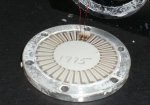Looking for how to build a homemade laser meter was how I found this forum, and I was wondering what the current status on DIY Power Meter design approaches was here now?
Some of the ideas I've read about include -
* The thermopile DIY Laser Power Meter - this appears to have been based on a sensor that was scavenged from some surpl. circuit boards on eBay, and which are apparently no longer available. Can anybody that has one of these things tell us the manufacturer and P/N of the sensor, or of the device it came out of - perhaps we can find another source?
(Christ, I just saw a pic of the innards of that sensor - is that a manufacture date of 1975??!)
* The DIY i/f board - from what I've read, this was a proprietary design, neither the source code (even sans libraries) nor the PIC microcode was ever released : by the author, who has now disappeared? :-? It also uses old RS-232 (vs. USB), and was designed to hook into the "part no longer available" DIY design above, so it's basically a lost cause now, is that correct?
by the author, who has now disappeared? :-? It also uses old RS-232 (vs. USB), and was designed to hook into the "part no longer available" DIY design above, so it's basically a lost cause now, is that correct?
* Various photodiode/solar-cell versions on the Sam's Laser FAQ site. Two issues with this approach appears to be max power levels (but can use an attenuator/ND filter), and the fact that the response curve on some of these devices can get a bit squiggly. But given we can't get any more of those low-cost eBay thermal sensors, perhaps this approach deserves a closer examination?
* The Benm diode-based design. This one is still a little rough around the edges, but got me to thinking about ideas for possible enhancements. Anyone using this, and how does it compare with the old thermopile design?
Did I miss anything? What do you all think is the best option right now for building a low-midrange (0.1mw to <5W) inexpensive homemade laser power meter?
Some of the ideas I've read about include -
* The thermopile DIY Laser Power Meter - this appears to have been based on a sensor that was scavenged from some surpl. circuit boards on eBay, and which are apparently no longer available. Can anybody that has one of these things tell us the manufacturer and P/N of the sensor, or of the device it came out of - perhaps we can find another source?
(Christ, I just saw a pic of the innards of that sensor - is that a manufacture date of 1975??!)
* The DIY i/f board - from what I've read, this was a proprietary design, neither the source code (even sans libraries) nor the PIC microcode was ever released :
* Various photodiode/solar-cell versions on the Sam's Laser FAQ site. Two issues with this approach appears to be max power levels (but can use an attenuator/ND filter), and the fact that the response curve on some of these devices can get a bit squiggly. But given we can't get any more of those low-cost eBay thermal sensors, perhaps this approach deserves a closer examination?
* The Benm diode-based design. This one is still a little rough around the edges, but got me to thinking about ideas for possible enhancements. Anyone using this, and how does it compare with the old thermopile design?
Did I miss anything? What do you all think is the best option right now for building a low-midrange (0.1mw to <5W) inexpensive homemade laser power meter?





